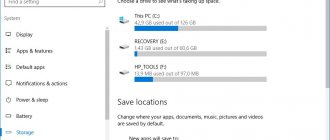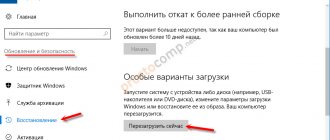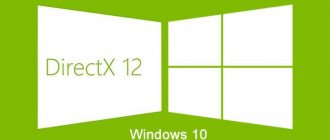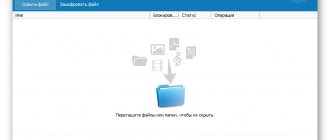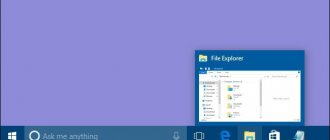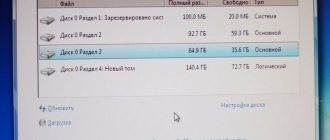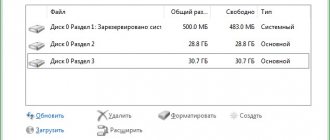What is the hidden section for?
You can hide your secret files in a hidden section and no one will find them
If you only use your computer to play games or watch movies and read sites on the Internet, you may not need this theme. If you use it more deeply and often delve into the intricacies of its setup and operation, sooner or later you will end up in the disk management utility, where you will find a hidden partition of the hard drive, the space in which is reserved for recovery. What’s most interesting is that the space is occupied, and the drive is not displayed in Windows Explorer.
The main purpose is to store the necessary files for computer backup recovery. But in no case should they be confused with the recovery image, because its size will be much larger than the allocated 100 to 500 megabytes, depending on the version of Windows. The newer the operating system, the more space it takes up. In addition, manufacturers themselves, especially laptops, can provide their devices with a small hidden partition so that they can be painlessly reset to factory settings with the possibility of recovery. Thus, each laptop will display two hidden volumes: system backup and recovery. Most often, their volume will be almost identical.
What does this opportunity give to the average user?
- First, data on a hidden volume is stored separately from public files, so it cannot be affected by various file and drive operations, such as formatting or compression. In this regard, you will be able to avoid some errors associated with the operation of Windows, and with certain knowledge and skills it will be much easier to restore the operating system instead of reinstalling it.
- Secondly, the presence of such hidden recovery partitions will make it much easier to resolve the issue of running several operating systems simultaneously.
- Thirdly, the most vital processes will be reliably protected from the actions of inexperienced users. For example, in Windows 7, the boot loader was stored on the system disk and therefore could be removed quite easily, which led to the loss of computer functionality. Now, to do this, you need to try hard, because these files are stored in a section marked “Reserved by the system.”
- And finally, if you are concerned about the safety of some files and documents, you can hide certain volumes in the settings; this way, an attacker or simply an overly curious friend will not be able to gain access or accidentally delete important data.
How to find a hidden system partition
You can find an existing hidden drive partition quite easily. To do this, you need to launch the built-in disk management utility, with which you can view all the necessary information and perform the necessary operations. How to get into it?
- On Windows 10 or 8, right-click on the Start button and select “Disk Management”.
- On older versions, click Start - Computer - right-click - Manage - Disk Management.
- On all versions, press Win + R and then copy from here and paste diskmgmt.msc into the search bar.
After the utility starts, you will see at least 4 lines: drives C and D, recovery partition and system reserved. Each of them can have the following attributes:
- System - a partition that contains files required for booting and normal operation of the system;
- Active - BIOS defines it as bootable;
- Main partition - allows you to select it to place system files and boot.
If everything is clear with the first two, then “Recovery partition” and “Reserved by the system” are worth understanding in more detail. In the first case, it will be displayed only in the disk management utility, and it is impossible to make it visible using standard tools. You can open the second of them by simply assigning a letter to it, after which it will appear in Explorer.
How to hide a hard drive partition using Group Policy Editor
This is a more serious method that allows you to restrict access to the system disk. It is useful if particularly curious people have access to your computer and may accidentally or intentionally damage something in the device.
Note : Group Policy Editor is only available in Windows 10 Professional edition. Those who have Windows 10 Home should use the first method. You can check your Windows version in your computer's specifications.
- Press Win + R and type gpedit. msc . The Local Group Policy Editor window opens .
- On the left side of the screen, select User Configuration – Administrative Templates – Windows Components – File Explorer .
- Now on the right side, find the item Hide selected drives from the My Computer window . Double click on it.
- Set the option to Enabled , and then select one of the following combinations. For example, Restrict access to drive C.
- Click OK .
- Log out and log back in for the changes to take effect. Optionally, you can simply restart File Explorer. To do this, open the Task Manager (right-click on the taskbar), find Explorer in the list of processes and click Restart .
To get everything back, follow the same steps, just select the Disabled in the Group Policy Editor window to hide selected drives.
Note : Using the Group Policy Editor, you can only hide certain drives, such as A, B, C and D. This limited set is motivated by the fact that this feature was developed for corporate needs, where their own rules apply. If you need to hide another drive, use the first method. And don't forget that the user can still access the disk using a specific file address.
How to create a hidden section
When automatically created during system installation
When installing Windows from scratch, you can create a hidden recovery partition. In new OS versions it will be created automatically. To do this, a number of conditions must be met:
- Installation from external media (disk, flash drive).
- No more than three volumes created; otherwise, the files will be copied to the already existing active partition.
- The top section where installation is carried out.
- Partitioning the drive from scratch, rather than installing it into an existing partition.
Having reached the stage of choosing an installation location, format the built-in drive, after which you need to delete all existing partitions, and then create at least two new ones, which will eventually appear as drive C or D. If you want to hide very important information from prying eyes, we recommend you need to create three volumes, one of which will not be very large in size, for example, 25–30 gigabytes. In almost all cases, you will notice that the very first thing on the list will be “Reserved by the system” with a volume of 100 to 500 megabytes. What’s most interesting is that you can delete this partition when reinstalling, but it will be created again. If you delete only drive C or D, and leave the hidden partition in place, then the data will be overwritten into the existing “System Reserved” volume. If you want to save the data on drive D and not delete existing volumes, the information will also be overwritten to the hidden partition.
By going to the Disk Management utility, you will be able to see both the main volumes and the hidden ones. To hide a section you want:
- Right-click on the one you want and select “Change drive letter or drive path.”
- In the window that opens, hover over the letter and select “Delete.”
Now this drive will not be displayed in Explorer, since it is hidden.
If a hidden partition was not created during installation
For example, you used a computer and realized over time that you need to create a new hard drive partition. But it is impossible to do this using standard Windows tools. Therefore, we recommend that you use the excellent Acronis Disk Director program. With its help, you can perform almost any operation with your hard drive: resize, split, copy, clone, merge volumes, make them hidden, and much more. The program costs money, a lot of it, but it's worth it. In addition, we will rarely feel remorse in our minds if we use a pirated copy. So, having found and installed Acronis Disk Director, follow these steps:
- The first step is to open the main program window, where you will see a list of all your volumes, including the recovery partition and “Reserved by the system.”
- Select the volume whose size you want to resize by clicking on it once.
- In the left column you will see a list of operations that can be performed on the selected volume.
- Select “Split volume”, after which the window for allocating space on the hard drive will open.
- Enter the size of each volume manually or automatically by moving the adjustment slider.
- Wait for the operation to complete and click the “Apply Pending Operations” button.
- If necessary, restart your computer.
- Next, you should re-open the program and select the volume you need.
- Select “Make hidden”, after which it will not appear in Explorer.
This way you can change the sections you need and make them hidden when you need it.
Method number 3. Command line.
Everyone's favorite Command Prompt has become a classic Windows tool, capable of performing almost any system task, which in turn has made it a valuable utility. In the instructions below we will look at an effective way to hide a disk or logical partition using it.
1. Press Win + Q to open the Start menu , then enter the cmd .
Open the application as administrator. Run utility will not work because it does not support the ability to run the command line in mode with full rights.
2. In the window that opens, enter the command Diskpart .
3. Now type List Volume and press Enter . This command allows you to display a complete list of drives on your computer.
4. Before you start hiding a logical partition, you must select its letter. This can be done using the select Volume 4 . Replace the value 4 with the number of the volume you need to hide.
5. There is one last step left. To complete the process of hiding the partition, enter the remove letter E . Replace E with your drive letter. To verify its accuracy, open My Computer and examine the list of found partitions.
Windows Explorer again using the My Computer . The logical partition is completely hidden from prying eyes.
Any of the listed methods is effective and in this regard they cannot compete with each other. The choice is yours alone. After all, each user may be comfortable with their own way of achieving the result - through disk management, the registry editor, or the command line.
Note! from the Starus Partition Recovery . After analyzing the HDD, the program will show you all the logical partitions that have ever been created on your drive. The tool will quickly and efficiently recover all partitions that were previously created and subsequently deleted or reformatted to a different file system. You can learn more about how the application works by following this link.
